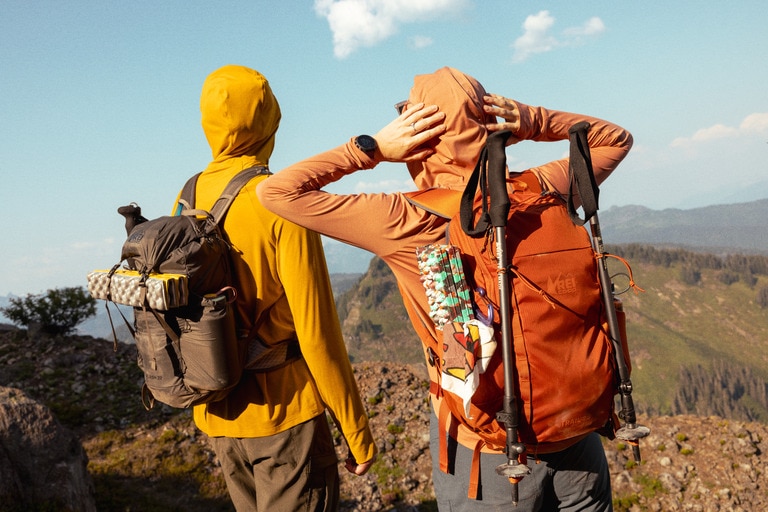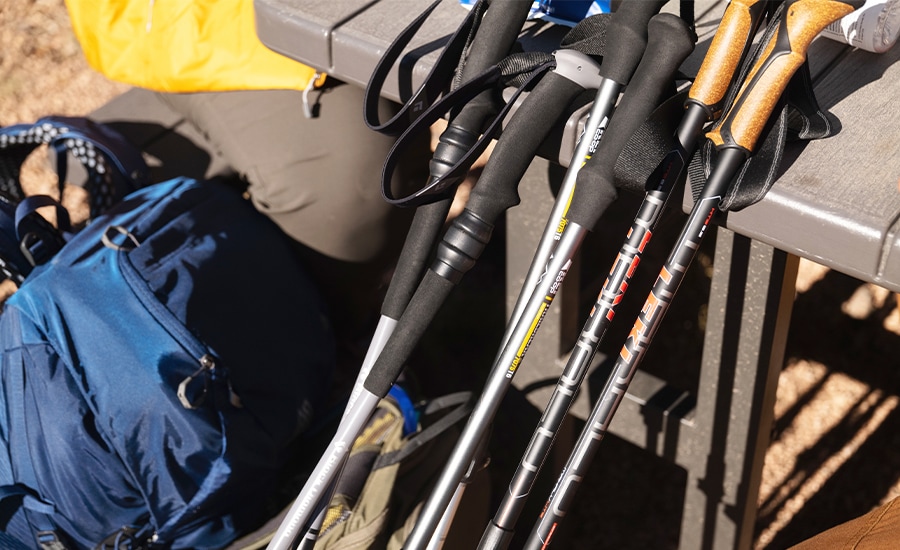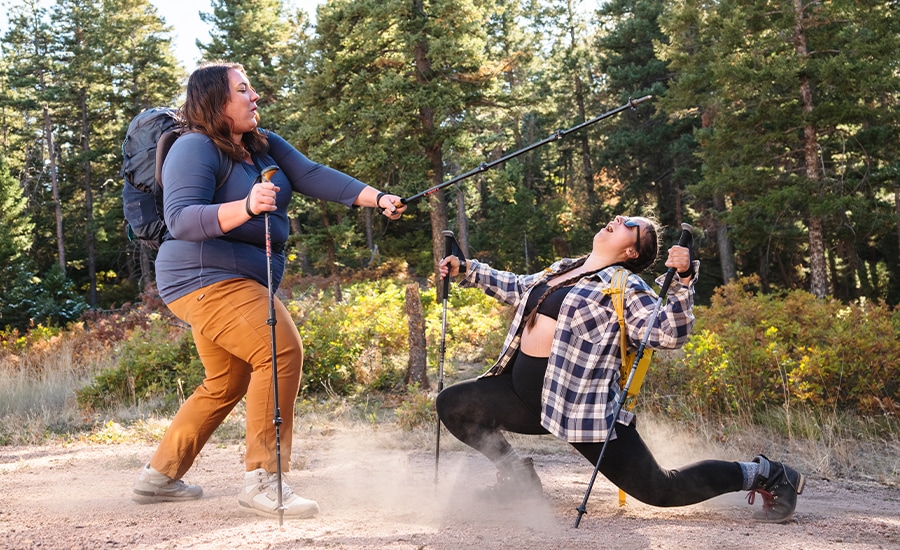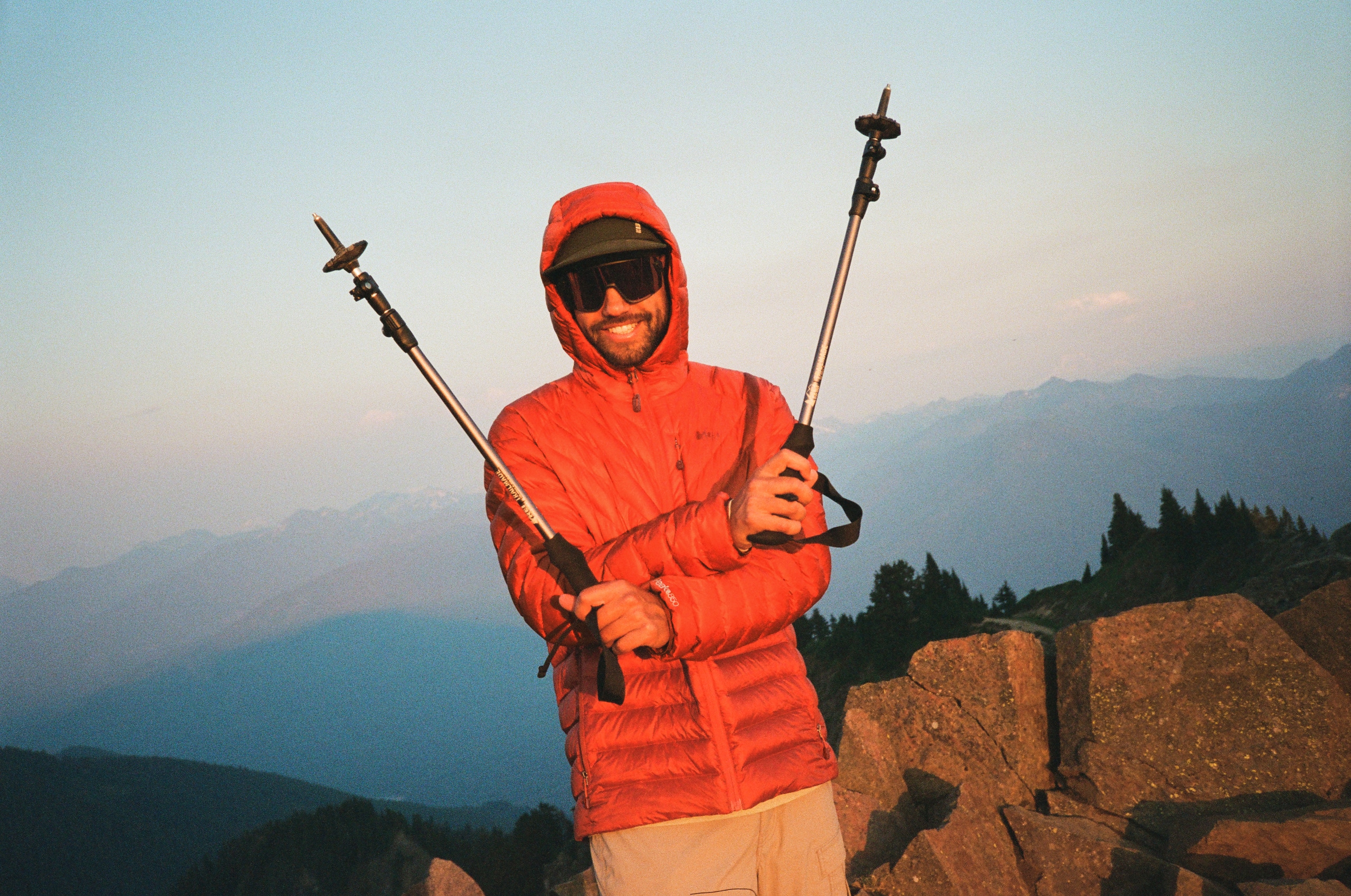Give yourself a boost next time you’re on the trail. Trekking poles increase your stability, efficiency and sense of security while heading uphill or picking your way back down. Incorporating upper body strength in your hikes also relieves some pressure from your legs and gives you the oomph you need to bag that next peak, take on another switchback or cross that last creek. Don’t believe us? Just ask our 18 expert testers, who took our best poles all over the country to pick their favorites.
There are a few key variables when it comes to choosing trekking poles—like weight, length and adjustability—so the best one for you will depend on your preferred activity. Our testers found trekking poles for all-around use, trail running, thru-hiking, everyday hiking and more. It’s time to put poles to pavement, or better yet, a long, winding trail.
The 7 Best Trekking and Hiking Poles of 2025: Test Results
Find our quick recommendations here or scroll to read the full reviews.
- Best All Around Trekking Poles: REI Co-op Traverse Trekking Pole - Pair
- Best Trekking Poles for Beginners: REI Co-op Trailmade Trekking Pole - Pair
- Best Trekking Poles for Hiking: Leki Januu and Khumbu Lite Trekking Poles - Pair
- Best Trekking Poles for Fastpacking and Running: Black Diamond Distance Carbon FLZ Trekking Poles - Pair
- Best Trekking Poles for Thru-Hiking: Black Diamond Distance Carbon Z Poles - Pair
Honorable Mention
Editor's note: We updated this guide on September 30, 2025 to include the latest model of the REI Co-op Traverse Trekking Pole
Jump to Buying Advice and How We Tested.

Best All-Around Trekking Poles & Editors’ Choice Award Winner
REI Co-op Traverse Trekking Poles - Pair
Score 97
Shaft Construction 7001 Aluminum
Grip material Cork
Minimum length 37 in. (size 95–120 cm), 41 in. (size 105–140 cm)
Maximum length 47 in. (size 95–120 cm), 55 in. (size 105–140 cm)
Collapsed length 23.5 in. (size 95–120 cm), 25 in. (size 105–140 cm)
Locking mechanism External lever lock
Weight (pair) 1 lb. 2.5 oz (size 95–120 cm), 1 lb. 3.5 oz. (size 105–140 cm)
Keep it simple and take 'em everywhere—that should be the unofficial motto of the REI Co-op Traverse Trekking Poles. Our testers loved the fuss-free design with just enough key features to make them reliable year-round companions, including two baskets for trail and snow.
Two sizes give you options based on your height; for ultimate flexibility, the shaft can be lengthened up to 10 inches at two lever locks, allowing users to adapt to changing terrain. (On the uphill, you might want a shorter pole, while the downhill may require a longer reach.) This came in handy when our testers approached a steep section of the Chilkoot Trail on the Alaska/British Columbia border. Our testers were able to shorten their poles for the more aggressive approach without compromising stability, giving them both better leverage to continue hiking in the slippery duff. The lever locks stayed tight over 8 miles on a fall trek through New Hampshire, too, rendering readjustments unnecessary.
Nice touches: Cork grips help keep your hands comfy over long distances, while the natural wicking material also helps keep sweaty palms from slipping or blistering. The cushioned straps come in handy on hot hikes and long hauls, or if you tend to lose poles on steep sections. (One tester was guilty of this.) Don't worry if you tend to beat up your gear: The tough-and-light aluminum poles survived a quarter-mile drop down a steep cliff with minimal scratching and zero dents, even after bouncing off boulders. "I didn't give a second thought to bringing them, because the hike was so much easier with that boost of upper body assistance," crowed one tester, who'd never been a trekking pole user before. "That's how gear should be." Buy here.
Bottom Line: If you’re looking for unfussy trekking poles for year-round use, you can’t go wrong with the REI Co-op Traverse poles.
Testing Stats:
- Days out: 68
- Testing states: Alaska, California, Colorado, Maine and New Hampshire
Best Trekking Poles for Beginners
REI Co-op Trailmade Trekking Poles - Pair
Score 90
Shaft construction 7065 aluminum
Grip material Foam
Minimum length 41 in.
Maximum length 55 in.
Collapsed length 25 in.
Locking mechanism External lever lock
Weight (Pair) 1 lb. 1 oz.
Budget-friendly but durable and comfortable options need to be more prevalent in the world of hiking aids, and we were thrilled that the REI Co-op Trailmade Trekking Poles checked all the boxes. These adjustable poles are still on the lighter side and provide plenty of flexibility when it comes to height, at a significantly lower cost than other poles on our list.
A strong aluminum shaft provides stability throughout your hike, while the two flip levers hold your adjusted height firm, even when you dig in. Comfortable rubber handholds allow you to grip without the slip, discourage blisters and make sure your wrists sit in a healthy neutral position, which came in handy with both of our testers. One self-proclaimed "beefy" fellow said, "I felt like these were sturdy enough to hold me. I'm a big guy and I didn't want a pair of trekking poles breaking down on me, and I was worried that it might be too much on my wrists, putting my weight down on my hands." He said he didn't have a problem on a 4-mile loop with 2 miles of downhill, and his arms felt great at the end. Our other tester, who has upper-extremity mobility issues, sang the Trailmade's praises for their ability to keep her arms comfortable and her movements powerful on steeper hikes. Buy here.
Bottom Line: Great performance at nearly half the price? You found the jackpot with the Trailmade Trekking Poles from REI Co-op.
Testing Stats:
- Nights out: 14
- Testing states: Maine, New Hampshire, New York, Pennsylvania
- Best testing story: These trekking poles helped get an entire family out hiking for the first time. New England natives who hadn't ventured far from the pavement went out with the author for a quick jaunt to a waterfall and pond tucked into the New Hampshire hills. The poles helped with unsteadiness on inclines and got all five hikers to the water and back with giant smiles.
Best Trekking Poles for Hiking
Leki Jannu Trekking Poles - Pair
Score 96
Shaft construction Aluminum
Grip material Cork/rubber
Minimum length 35 in. (Januu), 39 in. (Khumbu)
Maximum length 49 in. (Januu), 53 in. (Khumbu)
Collapsed length 25 in. (Januu), 26 in. (Khumbu)
Locking mechanism External lever lock
Weight (pair) 1 lb. 1.3 oz (Januu), 1 lb. 1.4 oz. (Khumbu)
Cut out the excess but don't skimp on the comfort, you say? The Khumbu Lite and Januu trekking poles from Leki have you covered. Coming in at just over one pound and easily collapsible down to the height of most daypacks, these poles are easy to toss into your pack or strap to the outside. The aid they provide on long trail days is worth the minimal additional weight compared to bringing no poles at all—trust us.
The Khumbu and the Januu (which has smaller dimensions) offer an ergonomic handle made with both sweat-absorbent cork and grippy rubber that won't cramp your hands an hour into your hike. In fact, the poles even aided one Maine-based tester in keeping up with his search-and-rescue crew. "The grips and silky-soft wrist straps worked great with my limited wrist mobility and kept me comfortable on a couple-mile hike in to help out some trekkers," he said. Thanks to an 8° angle, which helps to keep your wrists in a neutral position by transferring the weight and stability on your arm's long bones, he kept on hiking until the lost party was located—and then did it all over again on the way out.
Adjusting the height of the poles boosted our tester's comfort as well (the Khumbu extends to 53 inches, 4 inches longer than the Januu). "I could keep my wrist at the right angle for good leverage without impacting the balance boost these trekking poles gave me," he said. "That and the pointed carbide flex tips, which were great for grabbing on rock and dirt, were true lifesavers on the descent." Buy Khumbu Lite. Buy Januu.
Bottom Line: Trekkers will appreciate the comfort-conscious design of the sleek Khumbu and Januu poles.
Testing Stats:
- Days out: 16
- Testing states: Maine, Massachusetts, New Hampshire, Vermont
- Best testing story: A few testers discovered that trekking poles can easily make an impromptu chair, splint or water station on a search-and-rescue call in western Maine. They also helped a seasoned veteran leave the more fresh-legged rescuers in the dust out on the trail: The stability from the trekking poles helped the older tester keep on trucking while the others gave their legs a break.
Best Trekking Poles for Fastpacking and Running
Black Diamond Distance Carbon FLZ Trekking Poles - Pair
Score 98
Shaft construction 100% carbon
Grip material Foam
Minimum length 37.4 in. (size 110 cm), 43.3 in. (size 125 cm), 49.2 in. (size 140 cm)
Maximum length 43.3 in. (size 110 cm), 49.2 in. (size 125 cm), 55.1 in. (size 140 cm)
Collapsed length 13.4 in. (size 110 cm), 14.6 in. (size 125 cm), 15.75 in. (size 140 cm)
Locking mechanism External lever lock
Weight (pair) 15.9 oz. (size 110 cm), 1 lb. 0.4 oz. (size 125 cm), 1 lb. 1.6 oz. (140 cm)
Trekking poles might not be the first item you think of when it comes to trail running, but they've kept more than one athlete from throwing in the towel on tough sections. Runners and fastpackers alike know the value of incorporating your upper body strength to propel you up, down or through that last mile of trail—and nowhere does weight matter more than when you're vying for a personal record. Weighing mere ounces, the collapsible Black Diamond Distance Carbon FLZ Trekking Poles answer the call for light, fast and incredibly helpful.
While these are among the most expensive poles on our list, that price comes with a valid argument: These poles fold smaller, weigh half as much as aluminum poles and are just as strong as any other trekking pole we tested. In fact, in manufacturer tests, Black Diamond states the updated carbon fiber materials are 30% stronger than previous versions of this design. Our testers appreciated the nonslip, ribbed EVA foam handles that helped keep the sweat off their palms, and the straps didn't chafe one tester's wrists as they sped over the hills of New England. Need grip on ice, rock and packed ground alike? Switch between interchangeable carbide or rubber Tech Tips to keep you from slipping on any surface.
Slide these poles into place by pulling on the closest shaft to the handle, then quickly release them with a push of the button, pulling the three sections loose and collapsing into a Z again. Is it easy enough to do midjog? "Sure is—I pulled them out of my pack, set them up and packed them away without breaking stride," said our fastpacking tester. Buy here.
Bottom Line: The Black Diamond Distance Carbon FLZ Trekking Poles are ultralight poles on the fly that won’t interrupt your winged feet.
Testing Stats:
- Days out: 14
- Testing states: Colorado, Maine, Montana, New Hampshire, Vermont, Virginia
- Best testing story: "A few trail runners chuckled at me at the trailhead when I pulled out the poles," said one tester at a Continental Divide trailhead outside of Buena Vista, Colorado. "They took off about 20 minutes before my partner and I, but the looks of disbelief when we blew past them fastpacking, poles in hand, were worth the chuckles."
Best Trekking Poles for Thru-Hiking
Black Diamond Distance Carbon Z Trekking Poles - Pair
Score 98
Shaft Construction Carbon
Grip Material Foam
Length (fixed length) 43 in. (size 110 cm), 47 in. (size 120 cm), 49 in. (size 125 cm), 51 in. (130 cm)
Collapsed Length 14 in. (size 110 cm), 16 in. (size 120 cm), 17 in. (size 125 cm), 17 in. (size 130 cm)
Weight (pair) 9.3 oz. (size 110 cm), 9.9 oz. (size 120 cm), 10.2 oz. (size 125 cm), 10.4 oz (size 130 cm)
Weight is key when you're on the long haul. Black Diamond took that key and ran with the Distance Carbon Z poles, upgrading this newest model to be even lighter without sacrificing strength. Designed as a fixed-length trail-running pole, the pair weighs roughly the same as a roll of quarters, yet is strong enough to hold up a tent in a windstorm. What more could a thru-hiker ask for than the lightest pole—and a plenty tough one, too?
While these pared-down poles aren't adjustable, they are collapsable for easy carrying, and there are three lengths available to fit a range of heights. The fixed-length design takes away all the extra weight to make these some of the lightest poles on the market—no levers, extra shaft or big baskets. (They can be paired with Z-design snow baskets, though.) Our testers chose these poles as the best thru-hiking option, trading stashability for minimal weight and high durability. The strength of the carbon-fiber construction combined with the comfortable, ergonomic design of the handles combine to create the kind of pole you want with you 100 miles into a trek.
Testers couldn't stop raving about the extra-lightweight assist on long treks. "I never thought to bring trekking poles because of the weight, but I'd heard they could be helpful," said our ultramarathoner and thru-hiking tester after tackling 100-plus miles of the Colorado Trail. "One time out with these trekking poles and I was sold. I moved more efficiently with the poles than I had without." Buy here.
Bottom Line: For the lightest pole with the biggest impact, look no further than the Black Diamond Distance Carbon Zs.
Testing Stats:
- Days out: 50
- Testing states: Colorado, Maine, New Hampshire, New York, Pennsylvania
- Best testing story: "My first thru-hike section of the AT [Appalachian Trail] wouldn't have happened without these poles. I wanted to give up so early, but I would set the pole in front of me and tell myself, 'One more step. Four more steps. Ten more steps.' And propelling myself forward with those poles got me through it!"
Honorable Mention
REI Co-op Walker Staff - Single
Shaft construction Aluminum
Grip material Cork
Minimum length 20 in.
Maximum length 39.4 in.
Collapsed length 20 in.
Locking mechanism External lever lock
Weight (single) 8.8 oz.
We should all be so lucky to rock a stylish single trekking assistant like the REI Co-op Walker Power Lock Staff. This crankin' cane is as adjustable as the Trailmade (with two sliding locks) and as strong as the Khumbu Lite, but our testers liked the beefier grip even more than the Traverse poles: The Walker comes with an extended handle for additional support. If you like the stability of a traditional cane handle or like the width offered by the extended top, the Walker could make the difference between an OK stroll and a great hike. The 6-inch-tall cork grip still offers the traditional handhold of any other trekking pole, but with the ability to place more of your weight and balance through your arm and onto the trekking pole. It gave our testers the supportive boost they needed to keep their confidence on rocky trails and paved paths—and we're all for that. Buy here.
Honorable Mention
Black Diamond Pursuit Trekking Poles - Pair
Shaft construction 7000 series aluminum
Grip material Cork, algae-based foam
Minimum length 39.4 in. (S/M), 49.2 in. (M/L)
Maximum length 49.2 in. (S/M), 55.1 in. (M/L)
Collapsed length 22.8.5 in. (S/M), 24.8 in. (M/L)
Locking mechanism External lever lock
Weight (pair) 1 lb. 0.4 oz. (S/M), 1 lb. 1.6 oz (M/L)
Shock-absorbing trekking poles that soften the blow on your hike: They do exist. Testers and REI Member reviewers are thrilled with the Black Diamond Pursuit poles' progressive impact absorption (housed in the handle) that kept them comfortable and controlled on rocky, muddy, slick and rough terrain. Molded cork grips were effortlessly comfortable on the trail, while testers also loved that the extended grip (although minimal) was made from algae-based foam rather than the standard polyurethane. Two available grip sizes allow for the perfect fit and more comfortable hand positions, reducing strain (and complaints) on the trek. Adjust your height on the fly by opening the super-smooth soft-touch FlickLock+ and pressing on the pole tips to collapse, with the peace of mind that your adjustments will stay firm while you trek. Our testers loved them, but found the price a tough component for casual users. Buy here.

Buying Advice
When choosing the perfect poles for your treks, be sure to take the construction materials, adjustability, weight and basket compatibility into consideration.
Materials
Lightweight is great, but a trekking pole should be sturdy and steady above all. Look for poles made from strong but lighter materials, such as aluminum or carbon. Several of our top picks, such as the REI Co-op Walker Power Lock staff, and REI Traverse, Leki Khumbu/Januu and Black Diamond Pursuit poles, are made with aluminum, which is a strong and durable material. Carbon fiber poles (such as the Black Diamond Distance Carbon Z and the Black Diamond Distance Carbon FLZ) are much lighter weight and just as strong, but can also be more expensive.
Trekking pole grips are generally made with foam, cork or rubber. Cork is an absorbent and more forgiving material that will help you keep your grip even when you’re sweaty. Rubber is the best for grip and shock absorption, but might not feel the best over long distances: It tends to cause blisters more easily and doesn’t feel as nice on sweaty hands. Foam handles are comfortable, but not as durable as the other two options. Look for the material that feels best in your palms. Personal preference will certainly influence your decision, but a combination of two of these materials is a great compromise.
Adjustability & Weight
In this guide, most of our picks are adjustable in two places. However, we also included a set of fixed-length trekking poles, the Black Diamond Distance Carbon Z. We did this because of the benefits of both adjustable and fixed lengths: Adjustable poles are great for variable terrain and the freedom to share between users, adjusting for height differences. However, adding adjustable levers and extra length also increases the weight of each pole. The choice of adjustability versus weight ultimately comes down to user preference and activity. If you’re looking to trail run, then stashability and low weight will be key; if you’re thru-hiking, then weight and comfort should be your key features to consider. If you’re not sure which is the better choice for you, we suggest you err on the side of adjustability.
Baskets
Your trekking poles can take you from three-season adventures into the snowy fourth season with the right baskets. Some of the poles on our list, like the REI Co-op Traverse, come with a larger snow basket that can slide or clip onto the ends of your poles, while others might be sold separately. If you’re looking for a good option to cross over into snowshoeing, cross-country skiing or backcountry skiing, look for a pair of trekking poles with snow basket capabilities like the REI Co-op Traverse.
Types of Poles
In this case, we mean one or two—do you want a pair of trekking poles or a single hiking staff? Trekking poles are sold as a pair and designed to be used in tandem. A hiking staff, which can be called a walking stick or cane, is intended to be used by itself and often costs—you guessed it—half as much as a pair of trekking poles.
All of the poles in this guide are sold as pairs, except for the REI Co-op Walker Power Lock Staff.
Pole Length
With the pole tip on the ground by your feet, your arm should create a 90-degree angle when you hold the grip. This should give you enough wiggle room when the trail isn’t as flat—you’ll slide your hand down the grip of the shaft when ascending and reaching up and move your hand closer to the top or the knob when descending and probing lower ground. (All of the poles in this guide are adjustable except the fixed-length Black Diamond Distance Carbon Z.)
This table provides basic estimations for most folks:
Height | Recommended Pole Length |
< 5 ft. 1 in. | 39 in. (100 cm) |
5 ft. 1 in.–5 ft. 7 in. | 43 in. (110 cm) |
5 ft. 8 in.–5 ft. 11 in. | 47 in. (120 cm) |
> 6 ft. | 51 in. (130 cm) |
Adjustable poles allow you to fine-tune the length of the pole, but that tends to come at the cost of weight.
How We Tested

We sent 18 trekking, mountaineering, snowshoeing and running member-testers into the field with the best trekking poles available at REI Co-op. They hit the trails in sun, snow, mud, rain and foliage galore over a period of several months from the Southwest to the Northeast.
After hundreds of miles, our co-op member-testers filled out feedback forms that asked them to evaluate each pole’s adjustability, durability, grip, materials, features and ease of use. They rated the poles on a 100-point scale for each metric; the scores listed here are the averages. The eight poles featured in this guide received the highest average scores in the test.





























